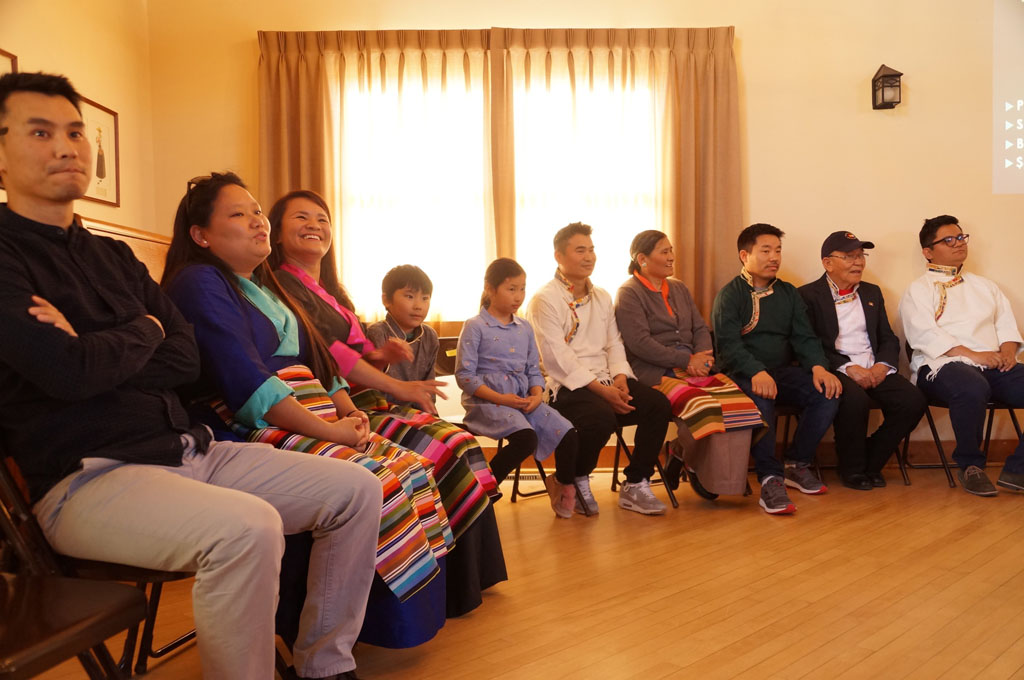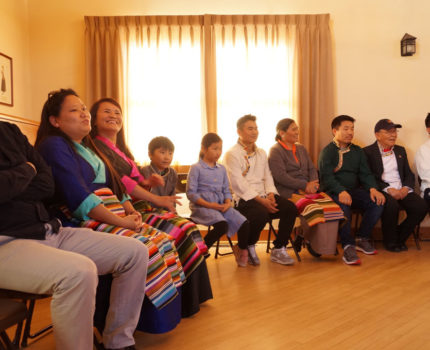A yellow school bus pulled up to Folklore Village, my favorite rural folk arts center, near Ridgeway, Wisconsin, and off piled 12 teens in shorts and flip flops, followed by three dozen parents and friends, bearing sizeable roasting pans to put on the potluck table, trunks, suitcases and odd-shaped cases I assumed were musical instruments.
As they crowded inside, the entryway filled with the aroma of Asian noodles, hot sauces, meat-filled momo dumplings, and a dozen versions of fried rice.
Never mind that I had already finished my readings and slide show for How to Make a Life: A Tibetan Refugee Family Adopts a Midwestern Woman. Never mind the crowd had missed hearing my “family,” all dressed to the nines in their traditional Tibetan chupa, eloquently answer questions posed by the audience. With the arrival of the school bus, the “launch” began again.
New books and new authors host “launches” – polite celebrations in which the author and the press invite interested friends, editors, and potential readers to buy one of the very first books, fresh off the press. At the same time, the book is sent cross country to book stores and its title appears on websites like Amazon.
This was my idea of a “launch” – an evening of Tibetan foods, dances, and music. At the center of the crowd was a lovely Tibetan American woman named Tenzin Choedon. The Wisconsin Tibetan Association had recruited her all the way from the Tibetan Institute of Performing Arts in Dharamsala, northern India. They wanted a professional to teach their kids authentic Tibetan dances and it worked. Now in the Tibetan “Saturday School” that met every week, dance classes throbbed with her drumming and her high-pitched exhortations for the students to move faster and sing louder. Her classes had more boys than girls, and kids performed in beginner, intermediate and high school levels. It was the real thing.
The 12 high schoolers who came to Folklore Village emerged from the downstairs changing room in elegant regalia; many of the costumes were antique. It had taken Tenzin Choedon a full day just to pack them into trunks with all their multiple pieces from three separate regions of Tibet, complete with shoes, jewelry, hair pieces, and masks. The mask dance performed by five young men knocked us off our seats. It was a piece from Tibetan opera, hardly ever allowed to be performed in contemporary China or Nepal, but as complex and ornate and culturally historic as, for example, Japan’s noh or kabuki. The dancers recited long stanzas in Tibetan, while jumping, twirling, and stomping, the long tassels from their chupa creating a dizzying choreography.
We ended the evening with Tenzin Choedon teaching everyone there, almost 100 people, two Tibetan circle dances. “Easy, easy,” she promised. “No partners.” In the center of the circle, she lifted her long skirt to show us the step, step, right, pause, left. We didn’t quite get it. She signaled the musician, Sonam Marpe, to begin playing his mandolin-like draNyen, dropped her skirts, and we stumbled along to the unfamiliar rhythms. The high school students rescued us from our awkwardness as they scooted in between and amongst us and started calling out the steps as they did them: step, step, right, pause, left. “Easy!” Or not.
Greg Winz, a regular Folklore Village dance leader, taught the next set, inviting toddlers who were tearing around to “sleep” in the middle of the circle as “foxes,” as we all did the Israeli dance, Hasual (The Fox) to “wake” the sleeping foxes. I think the visitors would have danced all night, but the yellow school bus, paid by the hour, was idling outside, and as quickly as they’d come, the crowd dispersed, leaving behind lingering aromas of curries and a bewondered crowd of non-Tibetans.
I have designated a portion of each book I sell to the Wisconsin Tibetan Association. My hope is that my story of discovering the rich Tibetan culture will be illustrated by stories of the by-now-well-settled refugees themselves. To each presentation I do, I will invite one or more of the 600 Tibetan Americans who live in Madison, including, of course, those of my 12 “family” members when they are not busy working or caring for their young children.
After four years of writing and editing, How to Make a Life was on its way.

